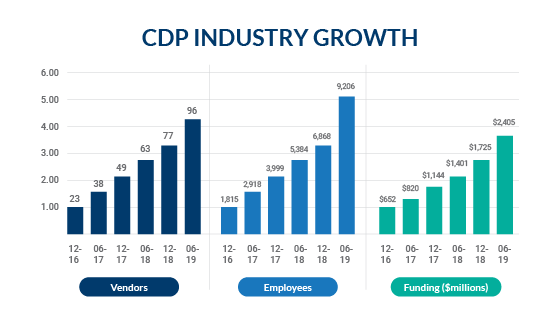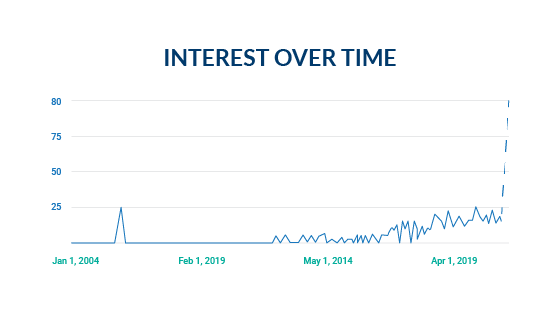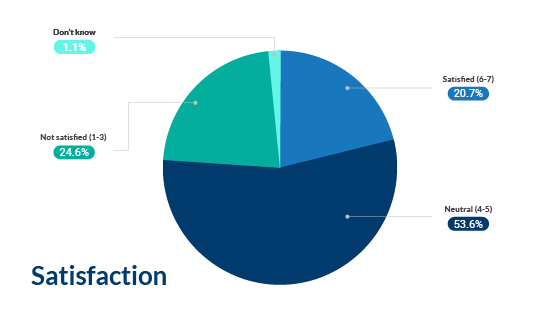Customer Data Platforms (CDPs) are a growing trend in the world of digital data, and were recently listed by Forbes Magazine as one of their Top Ten Digital Transformation Trends of 2021.

Customer Data Platforms (CDPs) are a growing trend in the world of digital data and were recently listed by Forbes Magazine as one of their Top Ten Digital Transformation Trends of 2021. Marketing professionals and CMOs in particular may wonder if the hype around CDPs is substantive or speculative. Is it worth investing in a CDP, and how can you know if your investment will pay off?
CMOs may remember the enthusiasm surrounding Marketing Automation Platforms (MAPs) in the past decade and might be wary of investing in a new technology that doesn’t meet their initial expectations. However, growth trends indicate that CDPs are a sound technology that many established software companies are adding to their marketing software suites. If you want to unify your data, create a single customer view, and allow real-time access to cross-channel data to target customer interactions and drive sales, a CDP is indispensable.
Growth of CDPs
The CDP Institute defines a CDP as “packaged software that creates a persistent, unified customer database that is accessible to other systems.” (1) While CDPs first emerged in 2013, they were in their infancy as far as full utilization of their potential. Since 2016, the CDP industry has experienced consistent growth.
The CDP Industry Update, released semi-annually by the CDP Institute tracks the growth of the industry since 2016. Across all segments of the industry (employees, companies, and funding) growth has been on a steady rise. Based on current data, the CDP Institute predicts that industry revenue will grow by 20% in 2021 compared to the previous year.
One of the biggest areas of growth is in established software companies such as Salesforce, Adobe, and Microsoft, acquiring campaign CDP companies to add to their marketing stacks. This willingness to invest in CDPs demonstrates their essential function in creating competitive software suite offerings. The demonstrable growth of the industry illustrates that CDPs aren’t a fad, but instead are an essential and flexible technology that will become a crucial aspect of digital transformation and marketing automation in the coming years.


Current Market
There are several categories of CDPs. Data CDPs and Analytics CDPs, store, segment and provide external access for customer data, or further automate distribution and provide predictive modeling of the data. The more advanced Campaign and Delivery CDPs add to that the ability to specify different treatments for different individuals within a segment and further personalization of messaging and delivery functions, including the cohesion of omnichannel data.
Why This Matters for CMOs
The appeal for Chief Marketing Officers to invest in a CDP is in the flexibility and material usefulness the platform provides. CDPs cannot only collect and use customer data, they go deeper in segmenting and analyzing that data. They also provide higher quality data by collecting from first-party sources and tying a wider range of information to the individual customer. This enables CMOs to make better marketing decisions and carry out their vision much more effectively, and efficiently. CDPs enable marketers to finetune their campaigns, creating a more targeted and cost-effective use of marketing dollars.
However, veterans of the digital marketing industry will remember the hype surrounding MAPs and the excitement over their potential uses. The annual Marketing Automation Satisfaction Benchmark Report analyzes the satisfaction level of marketing professionals with their MAPs. It emphasizes that company executives are putting greater and greater accountability on marketing departments to drive revenue. (2) With this responsibility in mind, the 2019 report demonstrates that marketing professionals are strongly dissatisfied with the current performance of their Marketing Automation Platforms.
In fact, less than 25% of respondents said that their MAP met most of their expectations. Marketers reported that the most important features they considered when investing in a MAP were the analytics and reporting capabilities, and yet these same features were the ones with the lowest user satisfaction. Clearly, the priority for marketers is usable information to enable their marketing goals, but MAPs alone are not delivering on this promise. In fact, only one in five respondents said they were satisfied with the quality of their data.

Does that mean MAPs are worthless?
Not at all. However, it does show that marketers are looking for ways to improve the functionality of their MAPs and more fully realize their potential. One of the major problems with MAPs creating the realities that marketers crave is that their full potential is impeded by the speed, usability, and quality of the data they’re able to access. While in the past, MAP performance has been geared toward measurements of email engagement, lead acquisition, and campaign impact, they now have the potential to incorporate data that more directly influences revenue generation.
Marketers are looking for post-handoff metrics, such as influences on bookings and purchases, and pipeline creation, all of which depend on data points across platforms, devices, and channels to truly deliver.
Right now, companies that are leading in the customer experience space can provide a rich brand experience thanks to their 360-degree view of the customer. This means going beyond marketing alone and working across their organizations to collect data in meaningful ways. The exponential growth in data coupled with the need for customer information to be assimilated in real-time means that MAPs fall short of their potential to deliver truly meaningful brand experiences when they don’t have the necessary data to leverage. This type of customer experience requires massive amounts of data, which is what CDP companies have been working to provide since 2016.
By utilizing a CDP, marketers can resolve their primary complaints about their MAP. The quality and accessibility of customer data provided by a CDP capitalize on the vision posed by MAP technology. Specifically, reporting and analytics can be tied to actionable, end-point marketing goals, and quality data will ensure campaigns hit their target.
Worth the Buzz
Consider the experience you want to create for your customers. With a CDP, you’ll be able to gather, unify, and clean up data from multiple touchpoints, including first, second, and third-party data. That data can then be synthesized to create a full 360-degree view of the customer, including behavior predictions.
Finally, you can activate this information through your MAP, sending customer profiles, audiences, and fully segmented data exactly where you need it, whether to CRMs, real-time targeted ads, or any other form of customer engagement, knowing your customer interaction will be more meaningful and valuable. And notably for CMOs, you’ll be able to track the user journey and provide easily accessible and high-quality metrics demonstrating ROI for marketing investment.
As the growth and current state of CDPs show, there’s more to this tool than just hype. With industry leaders and challengers in the DXP realm investing in CDPs, marketing professionals can be confident that the results of moving toward CDP technology are functional, attainable, and essential.
Resources:
https://www.cdpinstitute.org/Press-Release-Industry-Update-January-2021
https://offers.insightsquared.com/rs/054-ACZ-798/images/2019_MAP_Survery_Report.pdf

